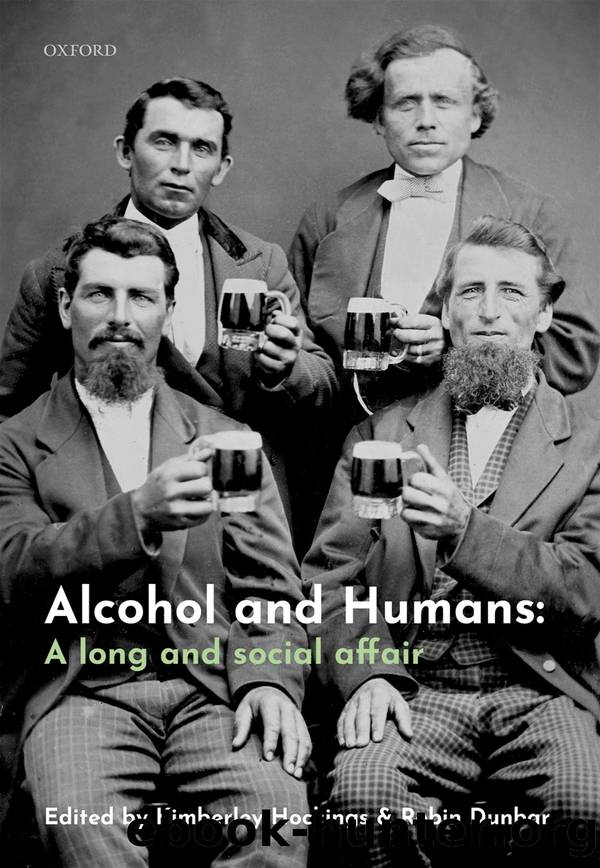Alcohol and Humans by Hockings Kimberley;Dunbar Robin;

Author:Hockings, Kimberley;Dunbar, Robin;
Language: eng
Format: epub
Publisher: Oxford University Press, Incorporated
Published: 2019-08-15T00:00:00+00:00
Figure 7.8 Humanâanimal composite sculptures from Göbekli Tepe.
© DAI, Photos N. Becker, Dieter Johannes
Figure 7.9 Imagery related to human heads/headless humans from Building D.
© DAI, Photos N. Becker, E. Kücük, K. Schmidt.
In several works, Whitehouse (1995, 1996, 2000) has presented the so-called modes of religiosity theory. It is based on the different levels of emotional arousal generated by rituals, resulting in two âmodesâ of ritual performances. The âdoctrinal modeâ is characterized by frequent repetition of low arousal rituals and teachings. Knowledge is stored and spread through texts and religious leaders. The high frequency of rituals leads to orthodoxy and a wide spread of teachings. The âimagistic modeâ on the other hand is based on rare, high-arousal rituals often including unpleasant and traumatic events, that create long-lasting memories and enhance group cohesion between participants. âImagisticâ rituals include fewer people and are of a more regionalized character. Typical examples are traumatic and violent initiation rituals, ecstatic practices, collective possession, or ritual acts including homicide or cannibalism (Whitehouse, 2000). Rarely performed rituals with high emotional impact leave vivid and detailed mental images (âflashbulb memoriesâ: Whitehouse, 2000: 304). This high emotional intensity is a necessity for rarely performed rituals to be remembered, and further fosters cohesion between the participants that often form close, localized, and exclusive communities of initiates (Whitehouse, 2000: 307). Whitehouse (2000: 311) sees the âimagistic modeâ of religion as predating the more organized doctrinal mode. The latter may be coupled with the emergence of literacy, as storage media for complex and canonized rituals are necessary.
So far, this theoretical framework has been tested in a PPN archaeological context only for Ãatalhöyük. Whitehouse and Hodder (2010: 127) collate a list of indicators for âimagisticâ religions. They point out the following traits: (1) the performance of collective rituals no more than once a year; (2) infliction of pain; (3) psychological torments; (4) trials of endurance; and (5) sometimes ecstatic components. For Ãatalhöyük, âimagisticâ rituals have been proposed as a key to generate social cohesion and group identities. Under the term âhistory housesâ, Hodder and Pels (2010) have developed an explanation for one of Ãatalhöyükâs peculiarities, the retrieval and reuse of sculptures and architectural elements as well as the retrieval, display, and reburial of skulls after decades. They argue that people started to relate to specific pasts/genealogies and houses; for these links, material evidence of the past was necessary and provided for in the form of spolia and ancestor skulls integrated into important houses that were constantly rebuilt in the same loci over long periods of time. The âhistory housesâ would relate to small corporate groups generating and upholding their identities and cohesion through these high-arousal rituals (Whitehouse & Hodder, 2010: 134â7). Interestingly, there are several parallels between the âhistory housesâ and Göbekli Tepeâs monumental buildings (Clare et al., 2018).
Given the general characteristics of Göbekli Tepeâs iconography and the highly possible use of drugs as just outlined, rituals held at the site could be described as âimagisticâ in nature. Göbekli Tepeâs imagery is centred on fear, a mythology related to death, and male sexuality.
Download
This site does not store any files on its server. We only index and link to content provided by other sites. Please contact the content providers to delete copyright contents if any and email us, we'll remove relevant links or contents immediately.
Sapiens: A Brief History of Humankind by Yuval Noah Harari(13962)
Sapiens by Yuval Noah Harari(5111)
Homo Deus: A Brief History of Tomorrow by Yuval Noah Harari(4678)
Pale Blue Dot by Carl Sagan(4604)
Livewired by David Eagleman(3529)
Origin Story: A Big History of Everything by David Christian(3467)
Brief Answers to the Big Questions by Stephen Hawking(3232)
Inferior by Angela Saini(3140)
Origin Story by David Christian(2984)
The Gene: An Intimate History by Siddhartha Mukherjee(2913)
Signature in the Cell: DNA and the Evidence for Intelligent Design by Stephen C. Meyer(2873)
The Evolution of Beauty by Richard O. Prum(2862)
Aliens by Jim Al-Khalili(2694)
How The Mind Works by Steven Pinker(2606)
A Short History of Nearly Everything by Bryson Bill(2503)
Sex at Dawn: The Prehistoric Origins of Modern Sexuality by Ryan Christopher(2406)
From Bacteria to Bach and Back by Daniel C. Dennett(2388)
Endless Forms Most Beautiful by Sean B. Carroll(2346)
Who We Are and How We Got Here by David Reich(2340)
